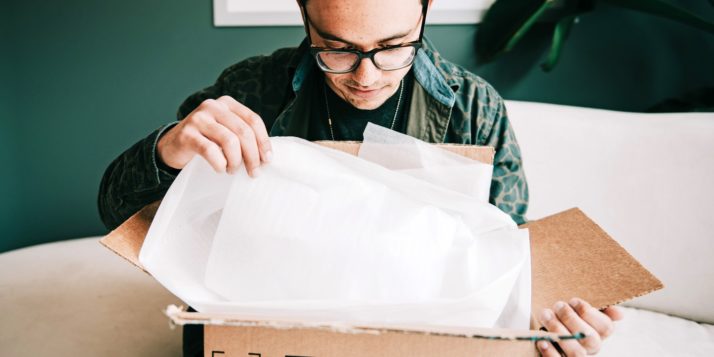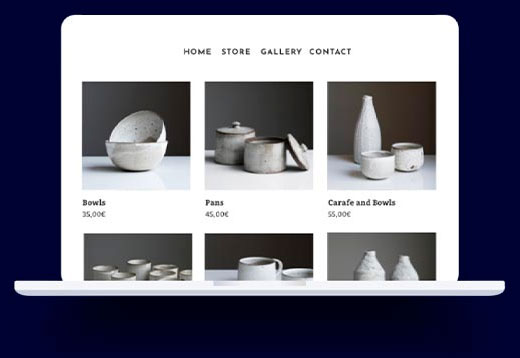When a customer buys something from your online store, their order has quite a way to go before it gets to them. The package might be shaken around in processing, get dropped on the floor, or have a heavier box put on top of it. But packaging does more than protect your products, it affects the way customers perceive your brand. From luxurious and exclusive to eco-friendly and sustainable—what does your packaging say about you?
In this article, we cover how to pack your products and how to design product packaging that fits your brand. So let’s look beyond the cardboard box and give your customers a unique experience they’ll want to share!
Start selling your products online with Jimdo.
1. How to choose the right product packaging
The first job of packaging material is protection. If goods arrive damaged, your customers will be disappointed and you’ll have deal with more returns. You’ll need sturdy packaging as an outer layer and filling material inside.
Your packaging choices will also play a big part in how you charge for shipping. For example, online shop indo-box.nl packages its Indonesian layer cake compactly to make it fit in most mailboxes and letter slots. This saves costs and the customer doesn’t have to be at home when the parcel is delivered.
- Order packaging samples. As a small business owner, you’ll probably want standard packaging materials with your own design or logo. Always order test sets with different sizes from several suppliers first.
- Think outside the box. Padded envelopes offer an alternative to boxes for shipping small items and clothing. Because these packages are so light, they can help you keep shipping rates low. They’re also perfect if you do local deliveries on foot or by bike.
- Choose 3 or 4 different sizes. This way, you’ll be prepared for most customer orders. If a customer buys three books from you, you don’t want to send them all separately, or use a huge box for something small. It’s a good way to set your small business apart from big retailers like Amazon.
Consider reusable packaging. Several shipping companies are already trying it. For example, Postnl has the reusable fashionpack and Zalando is also testing packaging that customers can return to be reused.
Test your packaging
Good packaging can be opened easily without damaging the goods inside. Here’s how to put your product packaging to the test:
- Pack and seal a few different boxes just as you would for a customer. Now try to open them with your hands. Can you do it? What if you use the kitchen scissors? Get friends and family involved too and tell them not to be too careful—your customers probably won’t be!
- Drop a packed box on the floor then put it in the shower for a while. This will give you a good idea how solid and water resistant it really is. You can then, for example, adjust the amount of filling material or add a waterproof inner layer.
- Send a package to yourself. See how your items look when they arrive. Did they get squished or damaged in transit?
What went wrong in your test round? You might need to tweak your packaging or even add opening instructions to the outside of the box to help customers open it safely.
2. How to design product packaging that makes your brand stand out
Your customer is excited for their order to arrive. If your brand name and logo are clearly visible on the outside of the box, that’s their first moment of joy, “Woo hoo! My order is here!”
Another advantage to branded shipping packaging is that your brand remains visible during transport and if the box is reused. Customers who see a box at a friend’s house will immediately recognize it, further strengthening their feelings about your brand. Research also shows that beautiful packaging activates the reward centre in our brain.
Design a logo that makes your business stand out.
Choose your colors
In 2018, 87 billion parcels were shipped in the United States. While we don’t have details about their design, how many do you think came in standard white or brown packaging? Probably millions!
Getting creative with your packaging design can help you stand out. Even if you’re going with standard packaging, most suppliers will offer boxes in a range of colors so you can have them match your brand and website colors. Companies like Stitch Fix has been doing this for years and their distinct polkadot boxes are instantly recognizable.
If custom boxes are too expensive, look at all the parts of your packaging. You can design your own address labels and packaging tape. For example, have tape made in a brand color or with your logo on it.
Choose a print
Your logo and brand name will be printed on the box. Your social media profiles are also good to mention. This reminds customers to follow you and share what they love about your products, or even film an unboxing video.
Another good example comes from e-bike retailer Van Moof. During delivery, the heavy boxes would often fall on the ground, bikes arrived damaged, and customers sent them back. This meant Van Moof had to pay out for damaged products, processing, and the cost of the returns. Plus, their customers had a bad experience.
As a solution, they now print a picture of a flat screen TV on the outside of the box. Couriers are more careful because they know that the content is fragile and the number of damage cases fell by 75%!
Choose sustainable materials
We mentioned reusable external packaging earlier. But you can also make a sustainable choice for packaging material inside the box. For example, if you want a protective layer between different products in a package, choose growth paper. This consists of two layers of paper with plant or flower seeds in between. After unpacking, your customer can use the wrapping paper to grow plants.
Lush Cosmetics are masters at this. Not only are their mail order packages sent in 100% recycled and recyclable boxes, they’ve swapped traditional Styrofoam for biodegradable, plant-based “packing peanuts” that you can throw in your compost. This approach fits perfectly with Lush’s brand voice and company values, too.
3. How to give your customers the best unboxing experience
With standard packaging, your customer’s attention is only focused on the product you send. By adding your own finishing touches, you can make unpacking your products a special experience that buyers can only get from your company. This turns opening the box into an event in itself and your customers connect this experience with your brand.
Here are some tips to make sure it’s a good one:
Let your brand personality shine through
If you make unwrapping your products a fun, exciting experience for your customers, they’ll associate the same feelings with your brand. So many mail order parcels these days are sent in boring, brown cardboard boxes with a standard black and white invoice inside. So it’s relatively easy to make your brand stand out.
- Include a free sample or tester. We all love a freebie. And including one is a great way to give your customers more value than they expected, draw attention to your other products, and even reduce the chance that they’ll return the order.
- Throw in a discount code for their next order. Want customers to reward customers for shopping with you and encourage them to order again? A discount code is a great way to reinforce customer loyalty and boost sales.
- Add an activity. Some companies give you a box and encourage you to make something with it. The online pet store Chewy, for example, encourages you to turn your box into a fun toy for your cat, then take a picture and share it on social media.
- Add a personal message. The smaller your business, the bigger your advantage here—including a handwritten “Thank you” note with every order is a cheap, easy way to delight your customers and forge a real, human connection. This type of dialogue marketing can make a big impact.
Here’s an example from sportswear brand, Apt Cavalier, straight from Sarah their CEO:
They also include their brand’s hashtag #BEUNSTOPPABLE along with a reminder to tag them in your product photos. A nice touch if you want to encourage happy customers to become your brand ambassadors by talking about your brand on social media and, as a customer, it helps you feel a part of their community.
Don’t fuel frustration
After hours queuing outside the Apple Store in Perth, Australia, the first person to get their hands on the new iPhone 6 dropped the phone as soon as they opened the box. Not a great customer experience—so what went wrong? Because the box didn’t open smoothly, the customer used too much force on it, and the phone fell out when the box opened. This was especially unusual for Apple, a brand that is known for the attention it pays to how it feels to unpack a new product, even paying attention to tiny details like the smell and feel of removing the phone’s protective film.
The good news is, if you’re a small business, it’s easier to experiment and make sure you avoid known frustrations like:
- Unnecessary packaging—especially plastic. Check out Puma’s “clever little bag” that’s replacing unnecessary shoeboxes. It’s recyclable, reusable, and saves 8,500 tonnes of paper per year!
- Packages you can’t open easily. Think about adding perforated edges to cardboard boxes, putting opening instructions on the outside, and avoiding too much tape and plastic wrapping.
- Packaging that damages the product when opened. Nobody wants another iPhone 6 incident.
Delight at first sight
Your parcel has finally arrived! You rip off the tape, open the box, and—at last—you see… an invoice and a return form. Huh.
While paperwork is usually the last thing you add to a box, it would be much better for the customer to see their new purchase first. Put bills, manuals, and other papers in the box first with your products on top (any special “thank you” notes being the exception). Customers who can see a product and hold it in their hands are less likely to want to give it back. So as a retailer, it’s better for your customer to think about the product first and not the price or the fact they can return it.
So channel your inner Marie Kondo and ask yourself: “Does this packaging spark joy?”
Your online store packaging can do more than protect
Good packaging keeps products safe. Great packaging helps you win loyal customers, and keep their business. Of course you want to make sure a product doesn’t get damaged in the mail but if you only see packaging as protective material, you’re missing out on an easy marketing opportunity.


